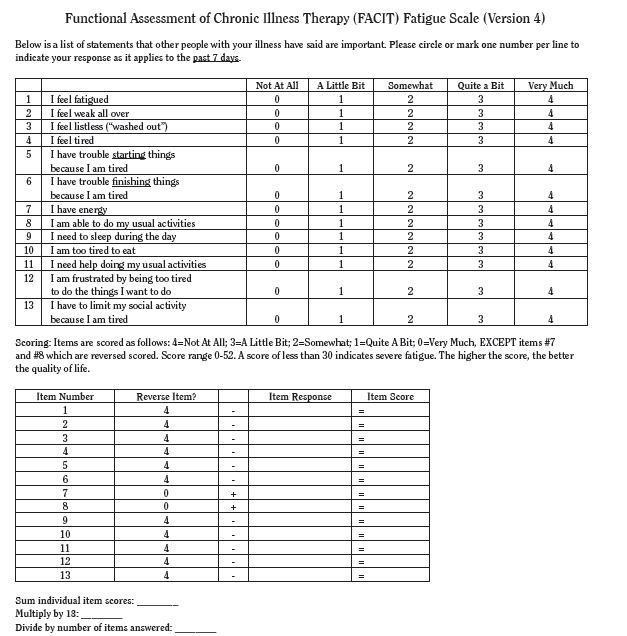Objective
To measure health-related quality of life of people with chronic illnesses. The FACIT questionnaires are some of the more commonly used questionnaires in national and international research settings. Fatigue is one of the most frequent complaints of the elderly and is strongly associated with loss of independence and decreased physical activity and functional decline. Mild depression, anemia, insomnia, and poor nutrition have been associated with fatigue[1]. However, many older persons report complaints of “fatigue” and “exhaustion” even when no underlying medical or psychiatric illness is present[1][2] Thus, the lack of an “underlying illness” makes the impact of unexplained fatigue even more crucial.[1]
Intended Population
Older adults who report fatigue.[1]
Method of Use
Although there are several validated tools for the measurement of fatigue, there is no gold standard[1][3]. One self report questionnaire that has been validated for use with older adults is the Functional Assessment of Chronic Illness Therapy (FACIT)Fatigue Scale (Version 4). The FACIT Fatigue Scale is a short, 13-item, easy to administer tool that measures an individual’s level of fatigue during their usual daily activities over the past week. The level of fatigue is measured on a four point Likert scale (4 = not at all fatigued to 0 = very much fatigued)[1]. The FACIT Fatigue Scale is one of many different FACIT scales that are part of a collection of health-related quality of life (HRQOL) questionnaires targeted to the management of chronic illness referred to as The FACIT Measurement System. The group tests newly constructed FACIT subscales on a sample of at least 50 subjects[1]. The FACIT tool has been translated in more than 45 different languages permitting cross-cultural comparisons.
Outcome Measures
Other assessment tools that can be used to measure fatigue includes:
Evidence
In a 2007 study[6], the FACIT Fatigue Scale was found to have high internal validity (Cronbach’s alpha = 0.96) and high test-retest reliability (ICC = 0.95). The correlation between the FACIT and Fatigue Severity Scale (FSS) was -0.79 tool comparison[1]. Thus, the FACIT has demonstrated reliability and sensitivity to change in clients with a variety of chronic health conditions and in the general population and in special populations such as the elderly and those living in rural areas.
References
- ↑ 1.01.11.21.31.41.51.61.7 Tennant K. Assessment of fatigue in older adults: the FACIT Fatigue Scale (version 4). Supportive Care in Cancer. 2015;23(5):1355-64.
- ↑ Avlund, K., Pederson, A.N., & Schroll, M. (2003). Functional decline from age 80 to 85: Influence of preceding changes in tiredness in daily activities. Psychosomatic Medicine, 65, 771-777
- ↑ Dittner, A.J., Wessely, S.C., & Brown, R.G. (2004). The assessment of fatigue. A practical guideline for clinicians and researchers. Journal of Psychosomatic Research, 56, 157-170.
- ↑ Butt, Z., Lai, J. S., Rao, D., Heinemann, A. W., Bill, A., & Cella, D. (2013). Measurement of fatigue in cancer, stroke, and HIV using the Functional Assessment of Chronic Illness Therapy – Fatigue (FACIT-F) scale. Journal of psychosomatic research, 74(1), 64–68. doi:10.1016/j.jpsychores.2012.10.011
- ↑ 5.005.015.025.035.045.055.065.075.085.095.105.11 ↑ Chandran, V., Bhella, S., Schentag, C., & Gladman, D. D. (2007). Functional assessment of chronic illness therapy-fatigue scale is valid in patients with psoriatic arthritis. Annals of the rheumatic diseases, 66(7), 936–939. doi:10.1136/ard.2006.065763


